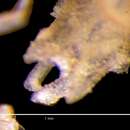zh-TW
在導航的名稱


“Ascorhynchus cuculus n. sp. (Figs. 203, 204)
MATERIAL EXAMINED:
Eltanin Sta. 362, 7-8, Dec 1962; 57°08.5’S, 58°57.8’W to 57°59.7’S, 58°50’W; 3,475-3,588 m, 1 larvigerous male, holotype, U.S.N.M. Acq. No. 113001.
DESCRIPTION: – A graceful, clean-limbed species without conspicuous spination.
LATERAL PROCESSES: Long and well separated, giving the body a broadly elliptical outline; cephalic somite produced forward as a heavy neck supporting the various anterior appendages, including ovigers; cephalic somite broadest just anterior to the eye tubercle, with a pointed conical anterior cephalic lobe, a smaller, median conical process dorsally over the insertion of the palps; eye tubercle massive, irregular, with several smaller processes above the small eyes; at the posterior margin of the cephalic segment and trunk somites 2 and 3 is and erect conical tubercle – this is produced as the median part of the ring-like process marking the posterior margin of the somites; ovigers seated in the cephalic somite anterior to the first pair of legs.
LATERAL PROCESSES: Separated by slightly more than 1.0, diverging distally with a dorsal conical tubercle at the end of each; lateral processes of the last segment short; abdomen situated ventrally so that it projects downward.
PROBOSCIS: Directed ventrally, triangular in cross section, shape B : 1.
CHELICERAE: Short; scape cylindrical, chela reduced to a knob.
PALP: Slender second segment the longest, 4th the next longest, 5th the shortest; the four terminal segments long, slender, and progressively shorter distally.
LEG: Slender, femur and 1st tibia subequal; 2nd tibia slightly shorter; tarsus shorter than propodus or terminal claw; terminal claw long, slender and pointed; no accessory claws.
OVIGER: Oviger simple, without heavy spines, but a series of reversed spines on the 6th segment; terminal claw short, without denticulations. On the holotype the ovigers carry two large molluscan eggs, each with a diameter of about 1.44 mm; hidden between the two eggs is a small larval mass with unhatched protonymphon larvae about 0.05 mm wide. The presence of the mollusk eggs has possibly prevented the animal from building up a large egg mass, or the foreign eggs may have crowded some of the original eggs off (Hedgpeth, 1964).
DIMENSIONS OF HOLOTYPE
Palp length
2.8 mm.
Trunk length
3.0
Proboscis length
1.5
Cephalic somite
Length
1.4
Width
0.5
2nd lateral process width
2.0
Chelicerae
Scape length
0.9
Chela length
0.1
Oviger length
5.5
Third leg
Coxae
1.75
Femur
1.7
Tibia 1
1.65
Tibia 2
1.3
Tarsus
0.8
Propodus
0.6
Main claw
0.9
Total leg length
8.7
DISCUSSION: -- This species appears to be closely related to Ascorhynchus cryptopygium Ortmann (see Utinomi, 1955) from Sagami Bay in general aspect, proportions, and the ventral position of the abdomen. The proboscis, however, is much broader at the tip than in cryptopygium, and lacks a definite constriction in the basal third. The eye tubercle is broader, situated near the center of the cephalic projection instead of near the base over the insertion of the ovigers (as in cryptopygium), and has conspicuous bosses or processes that give it an irregular lumpy appearance.” (Fry & Hedgpeth 1969, p. 123-124)
Ascorhynchus cuculus is een zeespin uit de familie Ascorhynchidae. De soort behoort tot het geslacht Ascorhynchus. Ascorhynchus cuculus werd in 1969 voor het eerst wetenschappelijk beschreven door Fry & Hedgpeth.
Bronnen, noten en/of referentiesAscorhynchus cuculus là một loài nhện biển trong họ Ascorhynchidae. Loài này thuộc chi Ascorhynchus. Ascorhynchus cuculus được miêu tả khoa học năm 1969 bởi Fry & Hedgpeth.
Ascorhynchus cuculus là một loài nhện biển trong họ Ascorhynchidae. Loài này thuộc chi Ascorhynchus. Ascorhynchus cuculus được miêu tả khoa học năm 1969 bởi Fry & Hedgpeth.